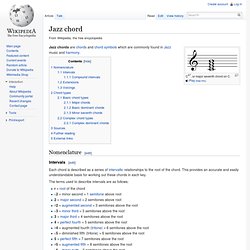

The HISS Homepage. Berklee Chord Game. Jazz Progressions. Jazz Progressions are simply common chord progressions in jazz music.

One of the most common progressions is the ii-V-I progression. The ii-V-I sounds at its best when you use seventh chords and their expanded voicings. As you already know from past lessons, the ii chord is a minor chord, the V chord is a dominant chord, and the I chord is a major chord. So the most basic Jazz progression is the ii minor 7 - V dominant 7 - I major 7. In the key of C, this progression is Dm7-G7-Cmaj7. The Harmonic Language of Jazz Standards. Have you ever met a player who can seemingly play any song in any key, coming up with different chord substitutions on every chorus?

Learning and Loving Music Theory. Kelvin, You actually caught a mistake on the roman numerals!

Thanks, I’ll have to fix that. The first and last chords of the progression are not 7th chords. Somehow I inadvertently typed “I7″ on the first chord of all the major keys. (Notice that I didn’t do that for the minor keys.) In the classical tradition, for the sake of stability, the first and last chords of a circle-of-fifths progression are usually triads, not 7th chords. Musical Analysis - detailed musical analysis of jazz and modern classical masterpieces. Share Jazz Giant Steps, Central Park West, and Modulatory Cycles John Coltrane wasn’t the first to experiment with equal subdivisions of the octave (experiments go back to at least 1825), but his Giant Steps placed this radically different approach to harmony front and centre within the jazz world.

Its unusual beauty and power still exert an influence, half a century later. However, in our fascination with the what of Coltrane’s octave subdivision, we can at times forget that its how is equally important. Both Giant Steps and Central Park West were constructed using its methods, and yet these classics couldn’t be more dissimilar in tone and artistic effect. This analysis explores those discoveries, as they are embodied within the techniques used to create these masterpieces. Danny Grissett: invention, design, and technique A condensed version of this article first appeared in the April, 2010 issue of DownBeat Magazine. Jazz chord. CΔ7, or major seventh chord on C Play .

Nomenclature[edit] Intervals[edit] The terms used to describe intervals are as follows: r 3 5 contains the root, a major third above the root and a perfect fifth above the root (major chord). List of chord progressions. ThinkingHarmony - in-depth discussions of jazz and classical harmony. Share The device of presenting ideas within the framework of a student-teacher conversation goes back at least as far as Plato, and probably beyond.

But thinkingMusic is itself a platform for presenting ideas, so why this ploy? While thinkingHarmony may appear to use this device, it's actually the real thing: a selection of email conversations that have taken place between my students and me, as part of our ongoing, long-distance lessons in classical and jazz harmony. Rather than use a teacher-student framework as a vehicle for my ideas, my intention is the reverse: to show that long-distance instruction can be deeply effective and enjoyable, given the right mix of technology, creativity and personal style. Scales and emotions.
See also a post about making chords from scales.

So maybe you want to write a song or an instrumental in a particular mood or style, and you’re feeling overwhelmed by all the scales. Here’s a handy guide to the commonly used scales in Western pop, rock, jazz, blues and so on. Click each image to play the scale right in your browser with the aQWERTYon. Electronic music production tutorials by Trifo. Jazz Chord Primer. FAQ : The Guide To Chord Theory - understanding chord construction/naming. Common Chord Progressions—The Complete Idiot’s Quick Guide. Writing chord progressions can be one of the trickier things about writing a music composition.

It would seem that creating a harmonious chord progression is just a matter of applying a few hard-and-fast rules. It isn’t quite as simple as that—there are a lot of choices available, and the rules aren’t always hard and fast. In this guide, we’ll look at the more common chord progressions found in both popular songs and other types of compositions and the rules for using them.
Note: All examples are given in the key of C. Build your own soundproof studio in 11 easy steps. I analyzed the chords of 1300 popular songs for patterns. This is what I found. For many people, listening to music elicits such an emotional response that the idea of dredging it for statistics and structure can seem odd or even misguided.
But knowing these patterns can give one a deeper more fundamental sense for how music works; for me this makes listening to music a lot more interesting. Of course, if you play an instrument or want to write songs, being aware of these things is obviously of great practical importance. In this article, we’ll look at the statistics gathered from 1300 choruses, verses, etc. of popular songs to discover the answer to a few basic questions.
First we’ll look at the relative popularity of different chords based on the frequency that they appear in the chord progressions of popular music. Then we’ll begin to look at the relationship that different chords have with one another. Lesson: Melodic Construction. Another Look at Melodic Construction in Improvisation What do we play?

Where does it come from? How do we make our own melody? The melody of the song or tuneThe rhythmic structureAn alternative positive melodic statement derived from the harmonic or rhythmic environment, or a melody from another song that fits the “changes”The development, embellishment, and ornamentation of the above ideas through the use of non-harmonic – , or non-chord -, tones. For the sake of this presentation, we will focus on the last category, particularly the role of non-harmonic tones.
A frequently used technique in melodic construction is the use of non-harmonic tones, followed by their resolution. I. Create Digital Music. Synthesizer and electronic music news, synth and music software. 200 useful chord phrases in C major. We've spent two full months of this blog exploring the basics of chord writing in rock music so you can create your own chord progressions (or chord phrases, as I like to call them).

Personally, I love this stuff! There are so many hidden symmetries to discover, so many subtle relationships between notes that you can play with. But... I know not everyone wants to master the intricacies of chords. Or even if you want to learn it all, you might have to write a song by tomorrow, with no time to learn even the basics. All right, then. Music Theory Cheat Sheet: Scales, Keys, Chords. The title of this post might be a little grandiose, but it’s (somewhat) true. Last post, I made reference to a cheat sheet that I had dreamed up for yall and I neglected to explain how to use it! What a jerk I am. So, I thought I’d clue you in about how to use this nifty resource. The cheat sheet consists of three different sections: Keys, Chords and Chord Construction. Key Click to Biggify The columns of this section correspond to different notes of the scale, the rows correspond to different keys. Learn these most common chord progression types and never get stuck again…
When it comes to playing songs, there are tons of progressions to learn. But I want to focus on what I think are the 3 most commonly used types. Chord Calculator. Absolute Beginner Part 1: Chords. So…you’ve just bought your first guitar, borrowed one from a friend or received one as a gift (and if that’s the case, please introduce me to this person…). Now what do you do? Well, if you haven’t got a clue at all, perhaps we can help you. Guitar Noise welcomes you to the first of our Absolute Beginner articles. It is our hope to get you started playing the guitar as quickly and as painlessly as possible. First, though, one very important thing to know: the guitar is not some magical device that somehow makes beautiful music while you simply hold it. Adding Flavor to Chords – Major and Minor 7ths – Basix. List of chord progressions.
Music. SounDesign. Music Production (Related) Thoughts about music and video games. Michael Tilson Thomas: Music and emotion through time. Additive rhythm and divisive rhythm. Additive and divisive meters. MusicalMind.org Ear Training Online. Outline of basic music theory. Scale Theory Chart. Needs. How to construct chords - Piano Clues: Free tips and lessons for playing piano, organ and electronic keyboard. 33 Ways to Make More Time in Your Life For Music-Making. 1. Disconnect. Tutorials. [My] Hardware & Software.
VST Plugins. MIDI. Hardware. Music and Impro Theory. BLUES. Software. Music Theory. Music Theory. E-Chords.com - Guitar Chords and tabs with key variations. Melodies. Composition & Songwritting. Chord Progression Generator. Guitar. Sampler - Tools. Free Music Theory Worksheets! AGE OF THE WHEEL: Circle of Fifths Chord Resource in Ableton Live. If you've turned on the radio in the last 30 years or so, you've probably noticed that almost all pop music sounds the same: rigidly formulaic, predictable and yet, oddly pleasing and familiar. This is no accident. Our Western ears have been trained to like music built around the circle of fifths. Tom Pankhurst's Guide to Schenkerian Analysis - Home Page. Music Theory Introduction.
Music 101: Intro to Music Course. Online Music Theory Flash Cards. Teoría - Music Theory Web.